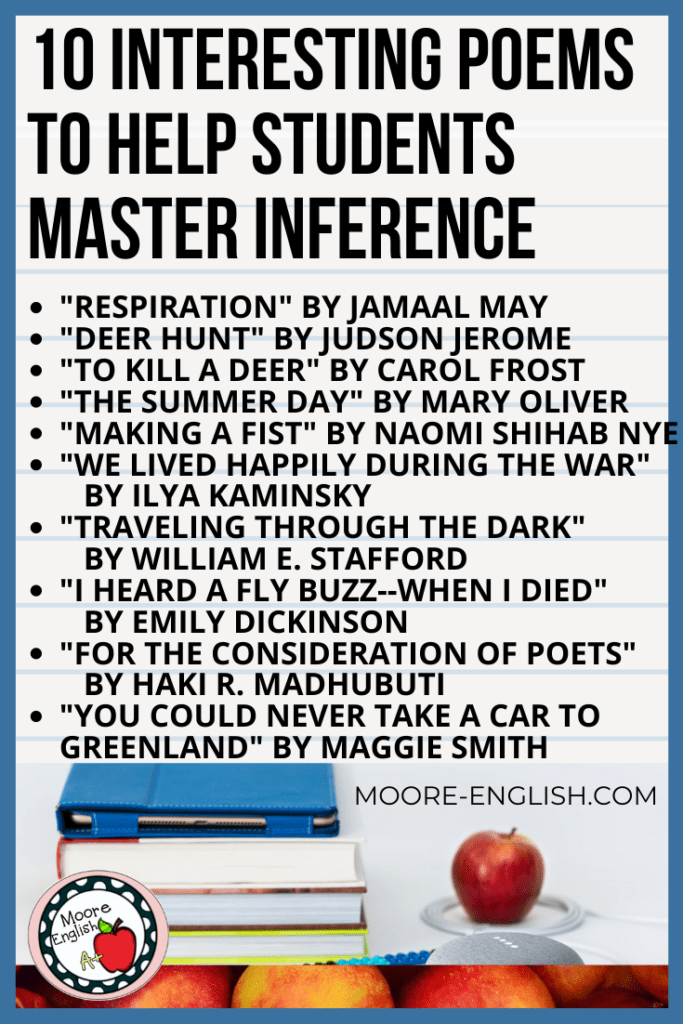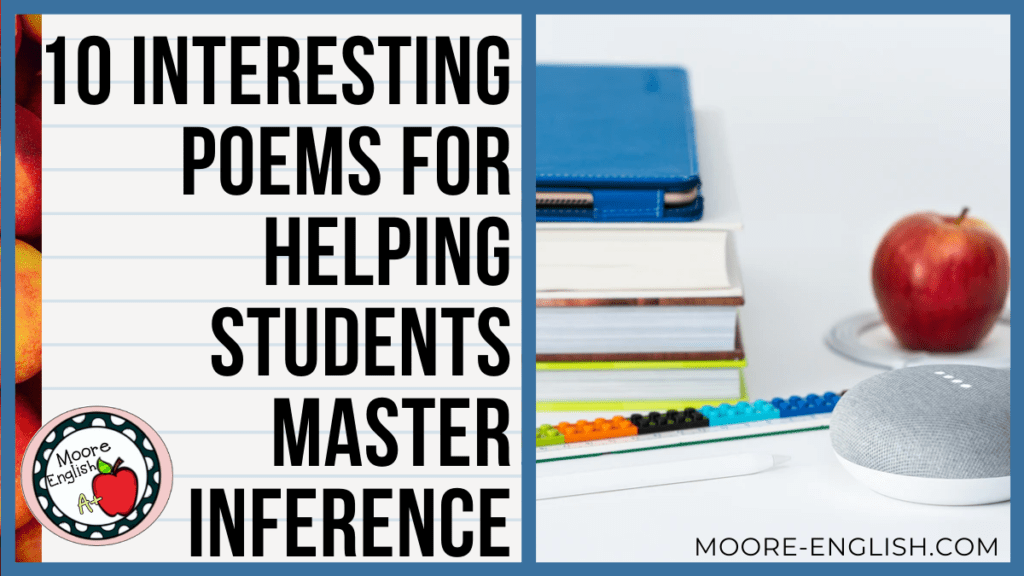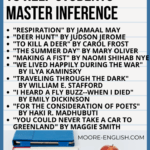Of all the skills involved in ELA class, inference is the one I spend the most time teaching. This is because inference is a foundational part of comprehension. As students grow, the texts they encounter become more dense, nuanced, and sophisticated. For this reason, students have to continually refine their inference skills.
As teachers, we have to balance this student need against curricular demands. For example, novels like To Kill a Mockingbird and The Great Gatsby certainly require students to make inferences. But novels are long. So they are better vehicles for bringing together several skills rather than focusing on a single skill like inference.
For this reason, when teachers want to give laser-focus to one skill, shorter texts might be better options. Of course, teachers could choose short stories. But if you want texts to be even shorter, then poetry may be your best bet. For this reason, I’ve collected 10 poems that provide great opportunities for practicing inference.
This post this post may contain affiliate links. Please read the Terms of Use.
9-10 Poems for Teaching Inference
With CCSS.ELA.9-10.RL.1 in mind, when choosing poems for my freshmen and sophomores, I look for texts that have ample evidence to help students support their inferences. These are texts that have explicit and implicit meanings. All of these resources can be found in my 9-10 Poetry Inference Bundle.
- “We Lived Happily During the War” by Ilya Kaminsky: The first time you read “We Lived Happily During the War” by Ilya Kaminsky, you remember it. This is not a poem to take lightly. So it resonates and sticks with students too. From a teaching standpoint, the poem’s ambiguity makes it a great text for teaching inference. This poem also lends itself to questions about main idea, point of view, tone, author’s purpose, and author’s craft. Check out the poem here. Or listen to Ilya Kaminsky read the poem here.
- “Making a Fist” by Naomi Shihab Nye: This is a poem I first use in my world literature class. The central symbol is ambiguous. So it really provides students with an opportunity to make claims and support their claims with evidence. This poem also encourages readers to think about mood, imagery, structure, main idea, and figurative language. Check out the poem here.
- “To Kill a Deer” by Carol Frost and “Deer Hunt” by Judson Jerome: Students often associate poetry with romance. Such topics don’t appeal to all readers. So I try to include poems that subvert my students’ expectations. Indeed, Carol Frost’s “To Kill a Deer” and Judson Jerome’s “Deer Hunt” are not really about hunting. In these brutal poems, Frost and Jerome use violence and imagery to provide commentary on masculinity and self-destruction. Check out Frost’s poem here and Jerome’s poem here.
- “Traveling through the Dark” by William E. Stafford: Poetry is a great way to help students practice inference because so much of poetry lives between the lines. Poets have to be so precise with words and phrases that a great deal of emotion is only ever implied. “Traveling through the Dark” is one such poem. This also ties nicely with Frost and Jerome’s poems. So these last three texts really provide an additional opportunity to move from inference to synthesis. Check out this poem here.
11-12 Poems for Teaching Inference
At the 11-12 level, I looked for texts that included significant uncertainty. Since CCSS.ELA.11-12.RL.1 challenges students to make more nuanced inferences about a text, I looked for slightly different texts for my juniors and seniors. These texts include deliberate ambiguity, imperfect resolution, and shifting perspective. These resources are all included in my 11-12 Inference Poetry Bundle.
- “Respiration” by Jamaal May: I’m always looking for poems my students haven’t already read. And I’m also interested in poets and poems my students don’t already know. Jamaal May is a living Black poet whose work most of my students have never explored. He’s also a deft writer whose writing leaves readers with room for inference. In the case of “Respiration,” May builds a powerful motif and uses a small moment to explore much larger parts of the human experience. Check out the poem here.
- “The Summer Day” by Mary Oliver: Few poems capture wonder and awe like “The Summer Day” by Mary Oliver. Its closing question is the stuff of poetic aspiration. The same closing question also makes this poem ripe for classroom analysis. What does the speaker want from the reader? Why does the language shift from first to second person? Answering these questions helps students make sense of the poem. Furthermore, the poem’s simple but vibrant language invites readers to visualize. Check out the poem here, and listen to Mary Oliver read her work here.
- “I heard a Fly buzz–when I died” by Emily Dickinson: With her idiosyncratic capitalization, dashes, and use of blank verse, Emily Dickinson is “the poet of paradox.” For this reason, her poetry is a great opportunity to work on important skills like analyzing syntax, author’s choices, and symbolism. Additionally, the motifs that carry throughout her poems offer students an opportunity to practice synthesizing across texts. Check out the poem here.
- “For the Consideration of Poets” by Haki R. Madhubuti: This poem features significant uncertainty and leaves readers responsible for providing their own resolution. This poem is also timely and relevant. Something about Madhubuti’s opening challenge and closing question engages readers, especially upperclassmen. Check it out here.
- “You Could Never Take a Car to Greenland” by Maggie Smith: In the last few years, Maggie Smith has become one of my favorite poets. She’s a deft writer whose work leaves readers with room for practicing making inferences, determining and supporting main idea, analyzing tone, and making meaningful connections. Check out the poem here.
Bottom Line
Making inferences is a life-long skill for readers. Helping students develop and practice this skill is central to being an English teacher. Finding texts for this skill is tough. So I hope these 10 poems help you meet the needs of your students. You can find all 10 in this 9-12 Poetry Inference Bundle. Let me know what other texts help you teach inference!


Photo by Thomas Kolnowski on Unsplash
















